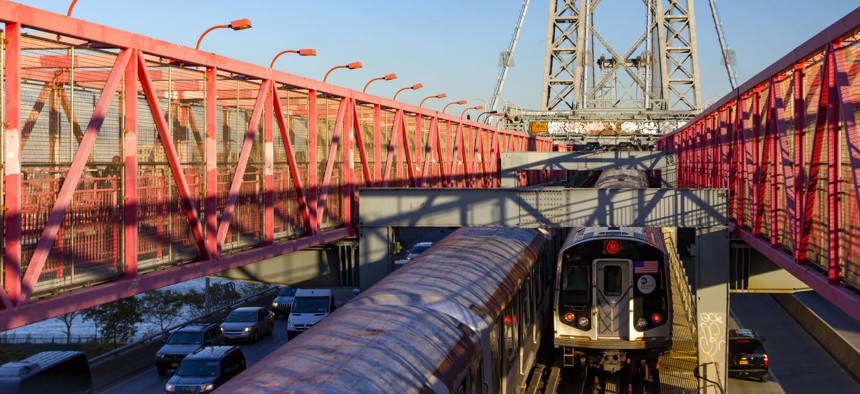Congressional Lawmakers Mull Need for Reliable Transportation Funding

The Williamsburg Bridge in New York City carries cars, trucks and subway trains between Brooklyn and Manhattan. Shutterstock
“We can’t keep pulling these rabbits out of our hat,” said U.S. Rep. Lou Barletta during a House subcommittee meeting on Wednesday.
Republican and Democratic lawmakers in the nation’s capital stressed the need for a stable funding source for road and transit projects, as a U.S. House panel convened on Wednesday.
President Trump is calling for a $1 trillion infrastructure package that would depend on both public and private investment. But Wednesday’s meeting of the House Transportation and Infrastructure subcommittee on Highways and Transit underscored longstanding difficulties Congress has had shoring up transportation funding.
U.S. Rep. Bill Shuster, a Pennsylvania Republican who chairs the full Transportation and Infrastructure Committee, said he and about 45 other congressional lawmakers met Wednesday with Transportation Secretary Elaine Chao, who briefed them on the Trump administration’s still-unreleased infrastructure plans.
“There’s a federal component to it,” Shuster said, “We’ve got to figure the revenues out. How we get more revenues.”
He noted that in addition to federal funding, the White House plan is slated to involve public-private partnerships and finding a way to “unleash” private dollars to help pay for projects.
Fellow Pennsylvania Republican Lou Barletta echoed Shuster’s comments on revenue. “We need to find a sustainable funding source for infrastructure. We can’t keep pulling these rabbits out of our hat,” the representative said. “These one trick ponies.”
The meeting of the highway and transit subcommittee focused on the implementation of the Fixing America's Surface Transportation Act, or FAST Act, highway and transit funding legislation that then-President Obama signed in late 2015.
After 36 short-term transportation funding extensions, the bill offered some certainty to state governments by authorizing about $300 billion of spending through 2020. But the FAST Act relied on one-time infusions of money, including $70 billion in general fund transfers.
Money flowing to the U.S. government from gasoline and diesel taxes—traditional transportation funding sources—has lagged as vehicle fuel mileage has improved. The trend threatens to continue as electric-powered and automated vehicles become more common.
At the same time, Congress has not acted to increase the gas tax for over two decades. It is currently 18.4 cents per gallon, equivalent to its level in 1993. The tax rate for diesel is 24.4 cents per gallon.
Atlanta Mayor Kasim Reed, who provided testimony to the subcommittee on Wednesday, highlighted steps Atlanta and the state of Georgia have taken to raise money for transportation projects, including a recent state-level gas tax increase.
“We’re working hard to keep our own house in order,” he said.
The prospect of greater private investment in transportation infrastructure drew attention during the hearing.
“Most transportation projects cannot generate adequate revenue to service debt or provide the return on investment required by private sector equity holders,” Michael Patterson, executive director of the Oklahoma Department of Transportation, told the subcommittee.
Reed said public-private partnerships, or P3s, work best in his view when they are centered around projects, rather than tax credits.
Tax credits are seen as a likely element in any eventual infrastructure proposal the Trump administration will put forward. The idea with the credits is to give private investors a tax break that would incentivize them to put money toward infrastructure.
Reed pointed to the Atlanta BeltLine as a good example of a P3.
The project involves converting old railways into a corridor with multi-use trails, parks and streetcar service. About $400 million of public support for the project will spur $3.8 billion in private investment, according to the mayor.
Patterson, who was speaking on behalf of the American Association of State Highway Transportation Officials, said any increase in federal transportation funding should flow through the existing FAST Act formula structure that guides how money is distributed.
And Gary Thomas, president and executive director of Dallas Area Rapid Transit, emphasized that the transportation funding law was crucial for agencies like DART.
“I cannot impress upon the committee strongly enough how important it is to keep the FAST Act intact,” he said.
Lawmakers on the Transportation and Infrastructure Committee seem to understand that.
Eleanor Holmes Norton, the District of Columbia’s non-voting delegate and the subcommittee's ranking member, said she signed a letter, along with U.S. Rep. Sam Graves, a Missouri Republican and the panel's chair, urging House appropriators to fully fund all FAST Act programs for the rest of 2017 and in fiscal year 2018.
As part of their efforts on infrastructure, the president and his administration have exhibited a keen interest in changing federal permitting and environmental review processes with the goal of speeding up projects.
But U.S. Rep. Peter DeFazio, an Oregon Democrat who is the ranking member on the full Transportation and Infrastructure Committee, said Congress has already taken significant steps to do this type of streamlining—some of which have not been implemented yet.
He said more than 90 percent of infrastructure projects already move ahead under exclusions that mean they don’t have to pass through a full environmental review process. Red tape, in DeFazio's view, isn’t the main problem when it comes to upgrading roads and transit.
“That isn’t the issue here,” he said. “You can’t streamline your way out of a lack of funding.”
Bill Lucia is a Senior Reporter for Government Executive’s Route Fifty and is based in Washington, D.C.
NEXT STORY: Building a cloud strategy on a solid foundation






